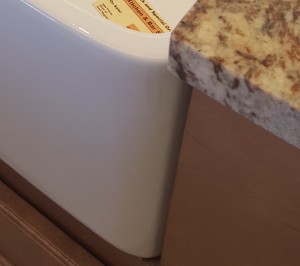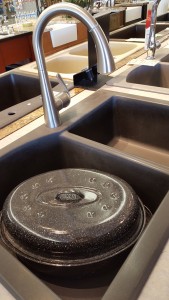If you’re installing new cabinets, countertops, and everything that goes along with a kitchen remodel, don’t make your kitchen sink an afterthought. A kitchen sink can be the focal point of this room—the bowtie, really. It can have both functional and style qualities that will make your time rinsing food, washing dishes, or doing any number of tasks much more enjoyable.
If you’re shopping for a new kitchen sink, we have some considerations you should keep top-of-mind during your search.
Mounting
The majority of kitchen sinks are drop-in, meaning you put them into the countertop opening with an exposed rim that goes around it. However, a recent trend is to install an undermount sink. This type of sink is typically seen with solid surface or granite countertops as the counter edge is exposed with the sink sitting just beneath the surface—making for easy clean-up. Simply wipe crumbs straight into the sink. If your countertop won’t allow you to install an undermount sink, some manufacturers are also making drop-in sinks with a low-profile rim.


Material
Depending on how much you use the kitchen sink and your decor theme, you’ll want to consider a range of materials.
Stainless steel is widely used and can range from inexpensive to moderately expensive. The thicker the steel, the better the quality (and increased noise reduction!). You don’t want to turn on your garbage disposal and have the entire house shake.
Composite sinks by brands like Blanco provide many choices as far as shape, color, and pattern. Composite sinks are made out of a blend of materials such as resin, acrylic, and natural stone, but are extremely durable, easy to clean, and scratch resistant. They also hide water spots well.
Enameled iron is a great option for homeowners looking for an old farmhouse sink style. These types of sinks can last a lifetime and are coated with a strong enamel coating. This glossy finish is non-porous and easy to wipe down. Just don’t use abrasive cleaners. If the enameled coating does chip, it will become prone to rust. Enameled cast iron sinks are heavy to install and may need extra support under the cabinet.
Fireclay sinks, (pictured above) also have the same smooth-as-glass finish as enameled cast iron. This is another durable option for a contemporary or country style home. Like enameled iron sinks, it’s non-porous and cleans with ease. You can keep it looking its best by adding a protective sink grid (like the one in this photo) to prevent scratches from abrasive surfaces, such as cast iron pots and pans. Note that there are a few downfalls to owning a fireclay sink. They are more likely to crack, however, cracks are not as visible because the entire sink is created out of one solid material. Fireclay sinks also weigh more than cast iron, likely meaning you will need additional support under the sink. Fireclay sinks are hand-made, so minor imperfections in size may exist. This may or may not be an issue with homeowners, however, because this artistic style can be desirable.
Stone (yes, solid rock) is also an option for your kitchen sink. Stone sinks are typically carved out of a single piece of rock, giving your kitchen a unique look. Because it is stone, it’s very heavy—weighing around 300 pounds. Because of this, you’ll need to build extra support to hold it in place. The “sculpture like” qualities of this sink will make it a talking point of your kitchen.
Shape/Design
Apron-front sinks, also called farmhouse sinks, slide right into your counter, leaving an exposed front panel. The sink apron is mounted flush to the cabinet allowing you to stand close to the sink. This makes it much easier on your back when you work at the sink for an extended period of time.
Kohler manufactures apron-front sinks with a unique feature added—a lip on the front sides of the apron that will cover the gap between the cabinet and the sink. This can come in handy as the cut made into the cabinet doesn’t have to be as perfect.


Flat bottom sinks, opposed to sinks with curved bottoms, can hold more dishes with ease. Also, dishes, such as wine glasses, can rest flat on the bottom of the sink, allowing more room to stack without fear of glasses tipping over and breaking.
Drain placement is also something to consider. New kitchen sinks will oftentimes put the drain near the back of the bowl. If your sink is piled with dishes, this will allow you to access the drain more easily as well as give you more usable space in the cabinet below for a waste basket.
Depth is all about personal preference. If you don’t want to lean over the sink too far, a shallow kitchen sink may be your best option. If you plan on piling a lot of dishes in your sink, opt for a deeper one. (You can always stop in one of our showrooms to test this out. Our floor models are displayed as if they were in a home.)
Think about the number of bowls you’ll need. Some kitchen sinks have a low divider that sits below the top level of the sink so bulky items can remain in the sink, yet you can keep clean and dirty dishes separate. You can opt for a sink with a single bowl or a double bowl where each bowl is separate.
You can also opt for unique bowl sizes and shapes to fit large items.
Finally, you need to know the placement and number of faucet holes you need before installation. You can have one or many, adding holes for the faucet, soap dispenser, filtered water, or sprayer. (At Handy Man, we can drill as many faucet holes as you wish—free of charge—if you purchase a kitchen sink from us).
Have questions about kitchen sinks?
At Handy Man, we can help you choose a sink for your unique needs and taste. You have more options than you may think. Stop by our showroom any time to chat with an expert about kitchen sinks. After all, kitchen and bathroom remodeling is our specialty. It’s like we always say — we’ll walk you through it.






